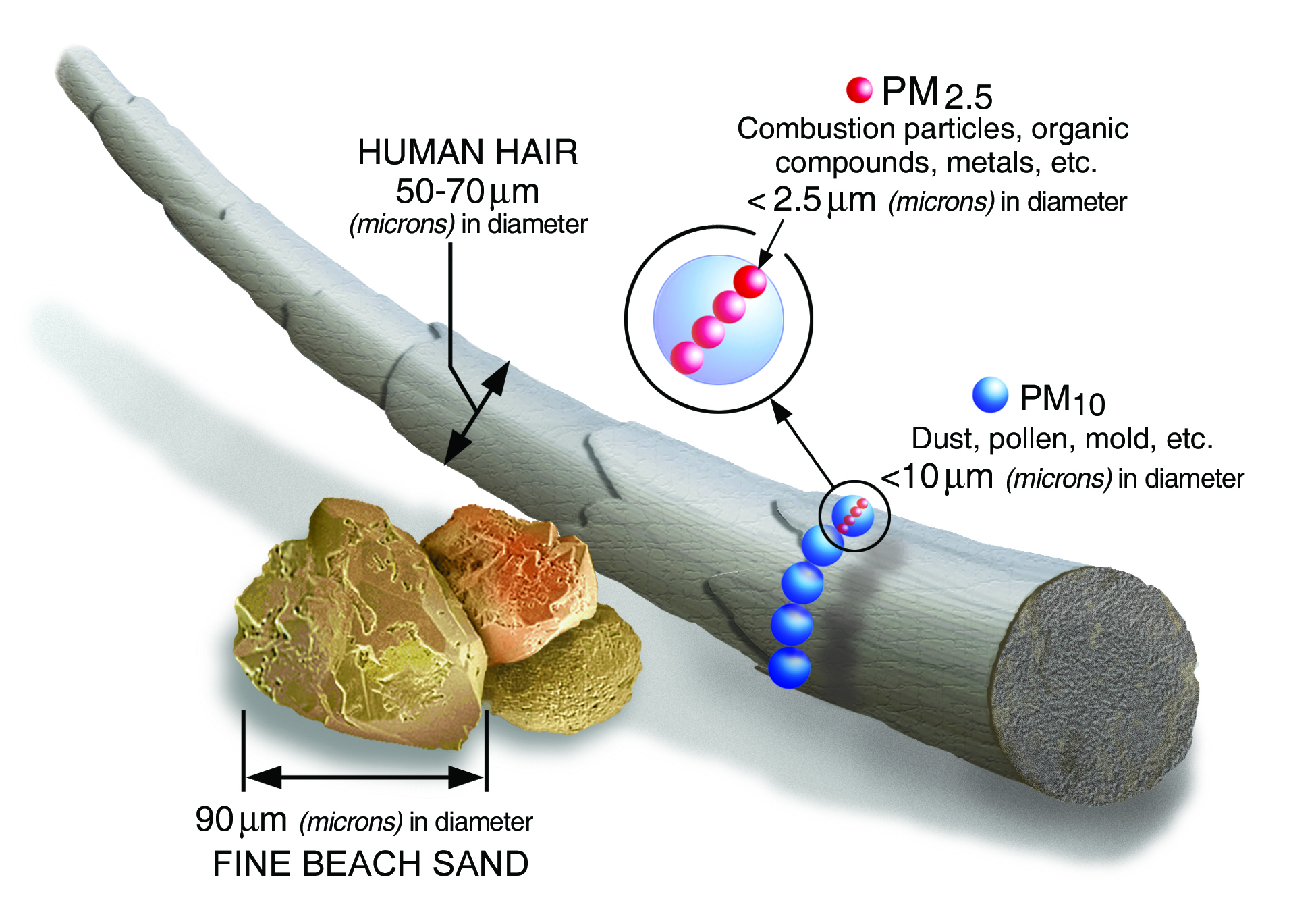There are specific requirements to manage risks arising from exposure to hazardous chemicals under WHS laws, including those associated with exposure standards, airborne contaminants and asbestos. No worker is to be exposed to a substance or mixture in an airborne concentration that exceeds the exposure standard for that substance or mixture.
Airborne contaminants
An average person can inhale more than 3,000 litres of air over an eight hour working day. In conditions of hard physical work, up to 10,000 litres may be inhaled.
The size of airborne contaminants varies from 0.01 μm (micrometres) to 100 μm in diameter. Airborne particles of this size settle slowly under the influence of gravity:
- ≤ 2.5μm particles can stay in the air for days or weeks.
- ≤ 10μm can stay in the air for minutes or hours.
50 μm and smaller particles are invisible to the naked eye. Particulate matter of ≤10 μm are able to penetrate the body’s natural defences.

Source: United States Environmental Protection Authority
Controlling exposure
A person conducting a business or undertaking (PCBU) must take all reasonably practicable steps to eliminate or minimise worker exposure. Exposure measurement must not be used as an alternative to controlling exposure through implementing hazard controls. In order to comply with Work Health and Safety legislation, PCBUs must be able to demonstrate that all reasonably practicable hazard controls have been implemented and are effective. PCBUs must demonstrate that all reasonably practicable attempts have been made to eliminate or minimise exposure and must not exceed the relevant exposure standard.
Where a Workplace Exposure Standard for an airborne contaminant has been established, exposure levels over 50 per cent of the Workplace Exposure Standard indicate that control measure may not be adequate.
If it is not certain whether the concentration of an airborne contaminant exceeds the relevant exposure standard, a person conducting a business or undertaking must ensure air monitoring is carried out on the workplace.
Air monitoring
Air monitoring is best undertaken after control measures have been put in place.
To get the most effective information, air monitoring should be arranged on a day when normal processing activities are taking place. An air monitoring program will usually last for a day, but can take longer if a variety of work processes need examining and, depending on the extent of monitoring required, the nature of the processes and the type of laboratory analyses required.
Air monitoring results assist in:
- identifying the best exposure controls
- checking existing controls are working effectively
- choosing the right level of respiratory protective equipment (RPE) or personal protective equipment (PPE) if other controls do not eliminate or sufficiently minimise exposure
- checking exposure levels after a process or production method has changed
- determining whether health monitoring for workers is required
- investigating concerns raised by health and safety representatives or workers
- identifying workers that have been or are being exposed to hazardous chemicals
- complying with advice from an occupational hygienist or statutory notices issued by SafeWork SA.
Air monitoring and the interpretation of results against exposure standards needs to be conducted by a competent person such as an occupational hygienist.
There are different types of air monitoring.
Exposure monitoring
Exposure monitoring involves air sampling within the workers breathing zone to estimate and interpret a person's risk from, or level of exposure to, airborne contaminants based on:
- eight hour time weighted average which is the average airborne concentration of a particular substance permitted over an eight‑hour working day and a 5‑day working week
- short term exposure limit which is the maximum average airborne concentration of a particular substance permitted over a 15 minute period and cannot be repeated more than four times per day. There should be at least 60 minutes between successive exposures.
- peak limitation which is the maximum or peak airborne concentration of a particular substance determined over the shortest analytically practicable period of time which must not exceed 15 minutes at any time.
A process is not considered to be under reasonable control if:
- the short term exposure limit exceeds three times the time weighted average for more than a total of 30 minutes per eight-hour working day, or
- a short term exposure limit value exceeds five times the time weighted average exposure standard.
Control monitoring
Another type of monitoring is called control monitoring which uses static or positional instruments at fixed locations to measure the level of airborne contaminants in an area.
Control monitoring is designed to assist in assessing the effectiveness of any implemented control measures. These monitoring results are not representative of actual occupational exposures and should not be used for that purpose. The results of control monitoring cannot be compared to the national exposure standard.
Further information
- Workplace exposure standards for airborne contaminants - Safe Work Australia
- Hazardous Chemicals Information System database - Safe Work Australia
- Guidance on the interpretation of workplace exposure standards for airborne contaminants - Safe Work Australia




